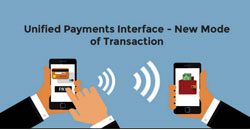National Payments Corporation of India (NPCI) has always been at the forefront to innovate and introduce new products and services at par with global standards. Our focus is in line with RBI’s vision of migrating towards a less-cash and more digital society, says Managing Director and CEO, NPCI, Abhaya Prasad Hota in an interview with Arpit Gupta of Elets News Network (ENN)
Unified Payments Interface (UPI) is a buzz nowadays in BFSI domain. What prompted NPCI to launch it and how is it unique from Immediate Payment Service (IMPS)?

Managing Director and CEO,
NPCI
UPI is a unique payment solution primarily because it has empowered recipient to initiate the payment request from a smartphone. It is an advanced version of NPCI’s IMPS which works round the clock. It is being improvised.
First, in IMPS, there is already a facility for immediate transfer of funds but what is not available is immediate receipt or collect, so we wanted to incorporate this facility. Secondly, there is a need of putting the IFSC code and account number at the time of sending the money in IMPS. So we thought of creating an ecosystem where we can avoid such large data entry and IFSC code and account number are masked in such a way that a new financial address is built. UPI offers a facility to identify a bank customer with an email-like virtual address. It allows a customer to have multiple virtual addresses for multiple accounts in various banks. Third, we found that there is an urgent need for improvising the success ratio in the eCommerce transaction. In card payment system, when the eCommerce transaction happens and people pay by cards, the success ratio is hardly 65 to 70 per cent. We thought of how can we make use of IMPS for eCommerce transaction. In the eCommerce transaction, it is almost like the merchant doing the collection. So if there is a button for eCommerce collect which is UPI or IMPS Plus then money can be collected. And the fourth thing we wanted to improve is the user experience to become more friendly. To ensure privacy of customer’s data, there is no account number mapper anywhere other than the customer’s own bank. This allows the customer to freely share the financial address with others. A customer can also decide to use the mobile number as the name instead of the short name for the virtual address like 1234567890@sbi.
 Keeping in mind four objectives to improvise the current payment services, UPI has been launched. It facilitates virtual address as a payment identifier for sending and collecting money and works on a single click. It also provides an option for scheduling “push” and “pull” transactions for various purposes like sharing bills among peers.
Keeping in mind four objectives to improvise the current payment services, UPI has been launched. It facilitates virtual address as a payment identifier for sending and collecting money and works on a single click. It also provides an option for scheduling “push” and “pull” transactions for various purposes like sharing bills among peers.
Has UPI been able to penetrate into the entire banking sector? How will it transform the world of payments?
As many as 29 banks have evinced interest to provide UPI service to their customers. Nineteen out of 29 banks have gone live with UPI while remaining 10 banks would also come on board soon. We believe that by June-mid, a few more banks will go live. With about 20-25 banks the applications will be released in the market. We are confident that several banks will join UPI this year. It is entirely a mobile-based service. With the smartphone there will be an application whereby customer would download it and they will register with one of the banks called PSP and their bank account may be with some other bank but they can avail the payment service from one particular bank. It’s also a deviation from IMPS where the bank providing the payment service and the bank holding the account are same. In this way, it is different.
 Do you think the country can cut down its cash transactions given the way cash continues to be a prime medium of transactions today?
Do you think the country can cut down its cash transactions given the way cash continues to be a prime medium of transactions today?
The entire market has not been covered under electronic payments. The area which has not been covered is mircopayment for an instance bus ride, train ride, buying tickets at the counter or in the bus itself by paying cash. We are poised to make transportation sector cashless. That apart, small purchases from grocery stores need to be brought under electronic payments. Many stores do not accept cards due to lesser amount of transaction value. We need to build an electronic micro-payment ecosystem and we are working on this. We shall be able to launch this facility in Bengaluru by next month as National Common Mobility Card. It would begin with the Bangalore Metropolitan Transport Corporation (BMTC) buses and would be extended to grocery stores and other places where acceptance infrastructure is built.
 RuPay came as a miracle for Financial Inclusion. What are your plans for debit and credit or combo cards?
RuPay came as a miracle for Financial Inclusion. What are your plans for debit and credit or combo cards?
RuPay card has already reached to 265 million people which is almost 35-36 per cent of the market share. It can be used for withdrawal of cash from nearby ATMs or micro-ATMs available with business correspondents of banks in an inter-operable way. We have already launched debit card and within the debit card we introduced classic and platinum cards. We are mulling to launch our credit card by this year. It was scheduled to get launched in June but it is getting delayed due to some reasons. We are working on to make it different. We are working on a combo card which would be functionality wise a little different. If the customer is choosing credit/debit card, at the time of purchase, that kind of scenario would be required for overhauling of the acceptance infrastructure. So it can not just be done like that, it requires a little bit of planning.
UPI is a unique payment solution which empowers recipient to initiate a payment request from a smartphone
Government is contemplating to go cashless. How NPCI is contributing to this cause?
For going cashless, we will have to see payment transactions in various segments especially those which are in bulk and repetitive like salary, pension and dividend. Nowadays, salaries and pensions are no longer being disbursed across the counter. They have all gone to NEFD ECS and now NPCI’s NACH. NACH is a centralised system unveiled to consolidate multiple Electronic Clearing Service (ECS) systems running across the country in a decentralised manner. It is a web-based solution which facilitates interbank, high volume, electronic transactions that are repetitive and periodic in nature. It empowers banks, financial, corporate and government institutions for making bulk transactions towards distribution of subsidies, dividends, interest, salary and pension among others. Transactions towards collection of payments pertaining to telephone, electricity, water, loans, investments in mutual funds and insurance premium are also processed seamlessly through NACH.
It plays a key role for processing bulk payments. With over 1,000 member bank participants now, we are well poised to support government’s efforts for modernising payment standards and digitising money transfers. Today, the eCommerce is fully electronic except cash on delivery. It is quite a significant part, we will have to see how we can make it electronic and we believe that UPI will be quite helpful in making everything cashless.
NPCI has started offering USSD based mobile service to make bank account holders access their accounts using an ordinary mobile phone
Give a brief about Bharat Bill Payment System. When it is likely to get launched?
The Bharat Bill Payment System (BBPS) – a comprehensive bill payment system that connects multiple billers who accept online payment for their products or services, is expected to be rolled out by July. It will enable customers to use various ways of online payments or, in case of those who do not have access to internet or do not use the internet to make payments, visit any physical touch-point belonging to any entity with a licence to operate a BBPS unit. It will be operated and managed by the NPCI. The BBPS will function as a tiered structure for operating bill payment system in India with a single brand image providing convenience of ‘anytime anywhere’ bill payment to customers.
What was your role in Pradhan Mantri Jan Dhan Yojana? Please define the linkage between Financial Inclusion technology and payment systems.
While implementing PMJDY-largest ever Financial Inclusion drive in the world, payment services offered by NPCI have been leveraged significantly. The eight services provided by NPCI-RuPay Card, Aadhaar Payments Bridge, Aadhaar Enabled Payment System (AEPS), Payment System Network of over 1000 banks, Enabling Payment banks for Financial Inclusion, USSD based Mobile Payment, Overdraft Verification Mapper and Provision of Accident Insurance – establish the linkage between Financial Inclusion technology and payment systems.
In few countries like Kenya, Bangladesh and Afghanistan, mobile-based services played a key role in introducing financial services to the people. In India, there is no such compulsion. However, NPCI has started offering USSD based mobile service to make bank account holders access their accounts using an ordinary mobile phone. It need not be a smart phone and does not require any application download. By dialling, *99#, a customer can do balance enquiry and remittances on a real-time basis.
How do you view the Payments Banks and Small Finance Banks?
The philosophy behind institutions like Payments Banks and Small Finance Banks is that existing universal banks may find it extremely difficult to provide basic financial services like acceptance of deposit, withdrawal when needed and remittance in a cost-effective manner. Financial inclusion initiatives would require new institutions with focus on transactional services by leveraging emerging technologies for payments. After careful scrutiny of the applications, the Reserve Bank of India has granted in-principle licenses to 11 players including the Union Department of Posts. Interestingly, five of them are from telecom industry (Airtel, Reliance, Vodafone, Idea Cellular and Aircel). It is enough to indicate that the RBI wants the large network of service outlets to be leveraged for Financial Inclusion. There are also three information technology/payment gateway companies (NSDL, Tech Mahindra and Paytm) who have already created innovative products in their domain and can replicate the same in Financial Inclusion. The reason for granting license to the Department of Post is to leverage the reach of 1,55,000 post offices in the country. The payment bank license will help bring dynamism in the organisation and modernise the century old savings and remittance procedure.
Elets The Banking and Finance Post Magazine has carved out a niche for itself in the crowded market with exclusive & unique content. Get in-depth insights on trend-setting innovations & transformation in the BFSI sector. Best offers for Print + Digital issues! Subscribe here➔ www.eletsonline.com/subscription/





















